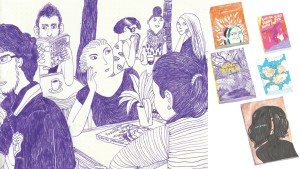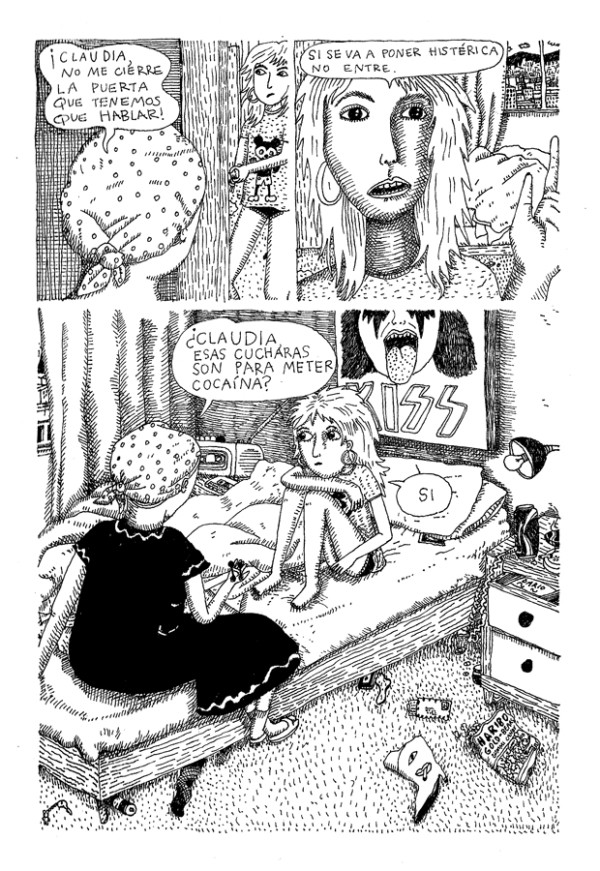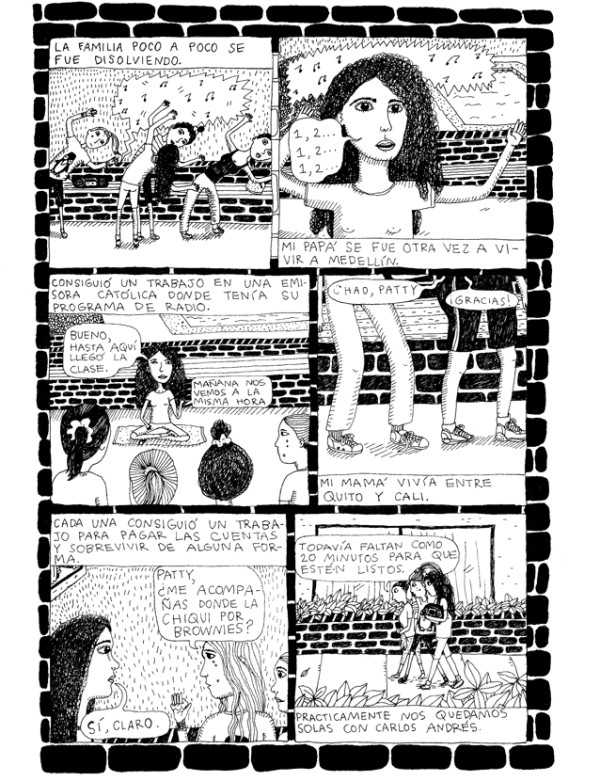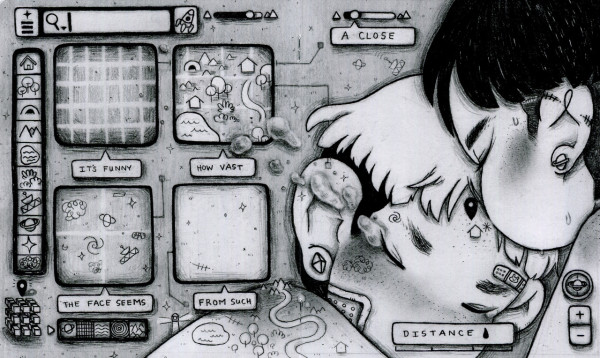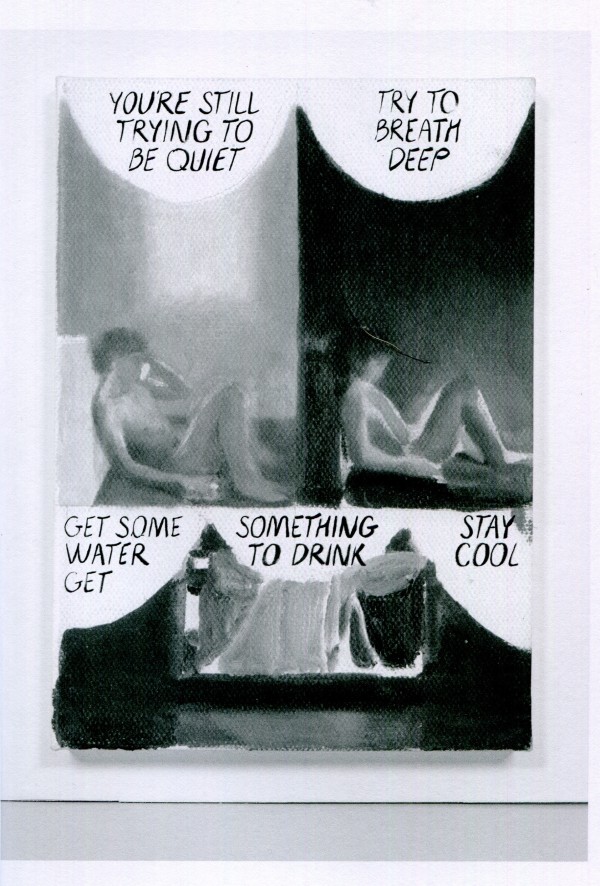The bad news is I’m sitting in an empty room while all my books (and most of the rest of my stuff) is in an entirely different house. This is because moving is hard and I’m bad at planning.
Thankfully, I have a lot of crowdfunded comics to look forward to once I get my change of address form all filled out. Here are two upcoming releases that I’m eager to have dropped in my brand new mailbox.
Sure, the Kickstarter is over, but that just means you can buy all these books directly from 2dcloud.com. This “season” of books fits perfectly together, though, so you should definitely read them all. Here’s the excellent lineup:
- Turning Japanese by MariNaomi
- Someone Please have Sex With Me by Gina Wynbrandt
- Virus Tropical by Powerpaola
- Trying Not to Notice by Will Dinski
I’ve had the pleasure of seeing both MariNaomi and Gina Wynbrandt read excerpts from these releases. Both are brutally honest about their lives and their desires, but that honesty is coupled with so much kindness and humor and empathy that they’ll flat out break your heart. Also, Mari’s lettering is the most immaculate in the business, and Gina’s neon colors make her comics feel like Lisa Frank’s bad trips.
Of all the books, Virus Tropical is the one I know the least about. The description is great, though:
Powerpaola uses a series of vignettes to transform the simplicity of middle-class family life into a thought-provoking narrative that would have been inconceivable prior to Colombia’s sexual revolution. Focusing on the lives of a family of women in the 80’s-90’s, Powerpaola’s tale highlights the excitement, danger, and struggles of a country in the midst of radical change.
And Powerpaola’s mark-making feels passionately obsessive. Just take a look at these preview pages:
And Will Dinski is just a gentleman of indie comics. His older work comprises a body of flawless minicomics, each one an attentively designed art object. For instance: a comic about maps that unfolds like an atlas; a comic about taking a Scientology test that is built around a scan of the test results; and some careful screenprinted covers with glow-in-the-dark ink. But I’ve heard that Trying Not to Notice features a much looser, less controlled Will Dinski, which is an exciting style to look forward to.
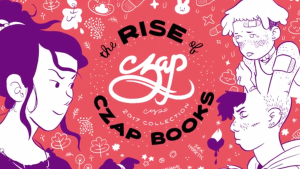 The Rise of Czap Books—The 2017 Collection
The Rise of Czap Books—The 2017 Collection
This one’s still going! Give Czap Books your money right here. The lineup:
- Witchlight by Jessi Zabarsky
- don’t tell me not to worry (i’ll worry all i want) by Kelly Kwang
- Egg Creme #1 by Liz Suburbia
Aw, dang, if only I had my comic collection and my personal computer. Then I could show you some excellent screen caps from Zabarsky’s digitally released Witchlight serial. Even then, it wouldn’t matter since Zabarsky’s remastering them for the book release. Hop over to the Kickstarter to see her exceptional choreography and intricate mapping. It’s about a witch and her kidnapped sidekick—a perfect fantasy setup.
Similarly, if I had my full computer setup, I’d show you Kelly Kwang’s quiet, grainy renditions from Frontier #12, a short comic all about the cosmic loneliness of the Space Youth Cadets. Here’s the only image I have access to:
See that quiet concern? That loving reproduction of digital aesthetics? That airbrush feel of love lived and lost? That’s what you can look forward to in don’t tell me not to worry.
And as for Liz Suburbia’s work, well, it has a feel of primal punk cartooning. Egg Creme is a sequel to the hit Sacred Heart, and the ink on the preview pages looks like it was applied with an angry razor despite its clear storytelling.
So there you go! It’s one million degrees here in Minnesota, and I’m stuck on the second story of a dirty, croaking house with none of my books. And you, dear readers? In these dog days of summer, what kind of literary comfort are you looking forward to?

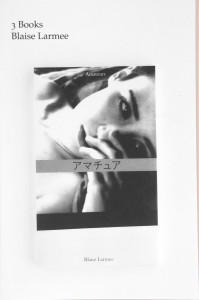 3 Books by Blaise Larmee (2Dcloud, 2015)
3 Books by Blaise Larmee (2Dcloud, 2015)
In talking about Blaise Larmee’s work, it’s said that it’s hard not to talk about Larmee himself. He has a confident, argumentative online persona, asserting himself in editorials often perceived as long-winded screeds, impenetrable as they are oppositional.
So before I being to dig into 3 Books, Larmee’s latest release, let me describe my first encounter with both his work and the culture surrounding it. In 2007, seeking respite from a relationship on the rocks, I went to visit my friend in Brownsville, Texas. It was the last year that people were allowed to cross the border without a passport, so we took an afternoon to visit Matamoros, Mexico, just across the Rio Grande. It was there, in the flea market plaza at the center of town, that I first saw Larmee’s work. His recent release, Young Lions, lay amidst gaudy Mexican historia comics. I was entranced by the loose linework haunted by (purposeful?) erasure, a stark contrast to the bold Mike Mignola and Mike Allred work I had been reading.
I offered the guy running the stand $20, but he wouldn’t take American money. Back across the border, I scoured the internet for details. There was nothing on Ebay (this was back when Ebay was in use), but I did find this review of the book on the Comics Comics site. With such a lively comments section, I was sure someone could help me get a copy of the book. I posted a request, hoping I could PayPal someone some money in return for a book, but I was, perhaps inevitably, trolled. I deleted my comment, but two days later, I got an email from someone who was ready to ship me a copy of Young Lions.
I’m getting a bit off track, but this context is important to how I approached 3 Books. That sense of desperate mystery in 2007 has always shaded my view of Larmee; 3 Books rewards being approached as an enigma or even as an outright lie. These challenges to classification are established immediately in the introduction by Pamela Lee. “The subject of an omnibus is almost exclusively that which it reproduces,” it starts. “Any critique we might fire slips past it. Only paratextual elements are vulnerable…” Lee is telling us (critics, and possibly readers) not to interact with Larmee’s work. Instead, she’s telling us to focus on the paratext: the cover, the intro, the context of the book instead of the contents.
Jumping back outside the book, the cover itself supports this approach. It’s immediately subject to a critique on the subject of its truth; it isn’t attached at the spine, so it shows that, despite the title, it’s not three books. It’s one book, all glued and sewn together. The title could have been 3 Stories or 3 Vignettes, but that’s too coy, too soft for Larmee. It’s three books or it’s one book, but both of those descriptions are wrong. “These are books best understood in profile,” Lee says at the end of her introduction, “the interiors of which are little more than extensions of the spine.” But that spine isn’t attached to the book(s); it wobbles around, inviting other interpretations. So can we believe Lee? Can we trust her as an authority on this book, on Larmee’s work, on art in general?
Lee has no bio or credentials listed after her intro; she’s just a name with a date. Doing some light searching, we come up with a possible match: an art professor named Pamela Lee with a bio at Stanford. Is this the same Pamela Lee? If so, it seems strange not to list her credentials since much of what she writes is an effort to make 3 Books unimpeachable; wouldn’t a noted inhabitant of the ivory tower of higher ed strongly serve that purpose? But maybe the absence of a bio is purposeful, pushing the reader to ask more questions and track down more paratext. Or maybe this isn’t the same Pamela Lee. Maybe this Pamela Lee is made up.
Larmee’s no stranger to making people up. This excellent interview with him, conducted by Sean T. Collins, mentions the fake Twitter account Larmee ran as cartoonist CF. Is it outside the realm of possibility that Larmee wrote the introduction himself, using it to point readers toward interrogating the paratexts of his own book?
Which allows me to transition back to my own early attempts at Larmee’s work. The email offer I received was from comixcomix@aol.com, and it was signed John. I was hoping he’d send the book and give me proof, such as a tracking number, at which point I’d pay him. He wanted payment first, which doesn’t seem so strange now, but I was young and suspicious those 8 years ago. I had no idea who this guy was.
As we emailed back and forth, trying to reach a deal, we got to talking about comics. It seemed like John read everything I didn’t, and recommendations littered every email he sent me. He was the one who finally pushed me to try Los Bros Hernandez’s Love & Rockets, who told me about Chester Brown’s Louis Riel, and much more. Unlike Young Lions, these were all available at Barnes & Noble. (My local comic store in La Crosse, Wisconsin, didn’t carry much past superheroes.)
John encouraged me to track down the comics as they were originally issued, though. Reading Love & Rockets in books organized by artist wasn’t the same as reading them as anthology issues where each featured all three brothers. The same went for Louis Riel; John thought it was impossible to separate the original serial issues from their context of Brown’s larger work on his Yummy Fur series.
One component of John’s insistence was the letter pages in the backs of each issue. It was living critique, and John had participated. I tried to find his stuff in the few issues I could find (and afford), but there was no John. In confronting him with this, he hinted at being prolific letterhack TM Maple or Comic Book Resource’s Augie De Blieck, Jr. I took these all to be jokes, of course—why use a pseudonymous email if he were famous?—but I never got his real identity out of him.
But again, I digress. The key point is that John, whoever he was, insisted that context was key for understanding a comic. And context is what 3 Books is all about. Dan Nadel, author of that long-ago critique of Young Lions, also reviewed 3 Books, giving it just under 300 words of contempt. Nadel does what Lee commanded not to: he focused on the material collected in the omnibus. And he found the work dull.
I’m sympathetic with Nadel; there are times when I want everything there on the page without all the dressings of context and layers of parody. And there are certainly some clunky pieces in 3 Books. The narration in the third story occasionally slips into a strange rhyming format that feels like a juvenile love (or lust) poem. I wouldn’t necessarily call it dull, though. Perhaps banal is a better word. Throughout the three books, the relationships Larmee portrays feel similar to what most college-aged boys go through, or at least what they want to go through: endless sex, dirty talking trying to be poetry, and romps through fancy hotels. If this were presented without the paratextual elements, 3 Books might end up feeling like nothing more than a typical teen romance movie. By Photoshopping his pages onto gallery walls (and I’m reasonably sure that’s the case—check out the floors under each painting), Larmee recontextualizes those scenes and moves them toward how some people wish sex felt: worthy of a museum. It’s intimacy cast as public performance—sex you can be proud of without demeaning it.
But it’s not without an element of satire, and the targets are many: the art world, the patriarchal view of sex, and Larmee himself. Why go through all these hoops to get this sex on the walls? Who benefits? Why is there an industry that supports this? But as usual, Larmee doesn’t give us the answers, so it’s up to whether we want to dig around for answers. It’s like an alternate reality game; what we get out of the book depends on what we put in. 3 Books is perfectly content to sit on the shelf, to be understood in profile, never giving any answers.
I never got an answer from John regarding Young Lions, and to this day, I still haven’t read it. The university email I was using to correspond expired a couple years after I dropped out of school, and when I finally enrolled again, my account had been wiped. Maybe John’s out there with Pamela Lee, with the people who bought Larmee’s fake paintings, and with Fake CF, all having a good laugh at our expense.
